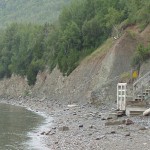Miguasha National Park
Archaeology »
Heritage sites»
Miguasha National Park
Location
Quebec
Country
Canada
Year of Research
1999
Culture
The palaeontological site of Miguasha National Park, in south-eastern Quebec on the southern coast of the Gaspé peninsula, is considered to be the world's most outstanding illustration of the Devonian Period known as the 'Age of Fishes'. Dating from 370 million years ago, the Upper Devonian Escuminac Formation represented here contains five of the six fossil fish groups associated with this period. Its significance stems from the discovery there of the highest number and best-preserved fossil specimens of the lobe-finned fishes that gave rise to the first four-legged, air-breathing terrestrial vertebrates – the tetrapods.In its representation of vertebrate life, Miguasha is the most outstanding fossil site in the world for illustrating the Devonian as the “Age of Fishes”. The area is of paramount importance in having the greatest number and best preserved fossil specimens found anywhere in the world of the lobe-finned fishes that gave rise to the first four-legged, air-breathing terrestrial vertebrates - the tetrapodes.

